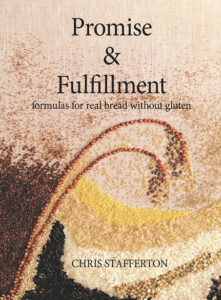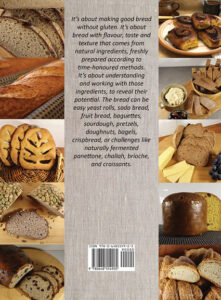unit 2 has been prepared using information from
‘Promise & Fulfillment: formulas for real bread without gluten’
ISBN 9780648554905

Promise & Fulfillment – front cover 
Promise & Fulfillment – back cover
Resources from this book are reproduced and used with permission of the author and the publisher.
preparing sourdough cultures
This method works well for preparing millet, quinoa, brown rice, sorghum, teff, buckwheat, and amaranth cultures. The dominant aroma is different with each. Millet tends to be fruity and yeasty, not unlike beer. Quinoa tends to be nutty and earthy with some fruity overtones. Brown rice tends to be fruity and slightly sweet, not unlike a light white wine, perhaps a chardonnay. Buckwheat tends to be slightly sweet and grassy with earthy notes. Teff tends to be slightly earthy with chocolate overtones, especially brown teff.
Teff can be fermented spontaneously in two days to make ‘Injera’, however, to prepare a starter culture I prefer to follow the process of maturing the culture to ensure it is a stable culture for long term use.
As the culture is prepared a small amount of immature starter will be disposed of as waste. This starter is not suitable for use in preparing food as the process of refining the microbe communities has not progressed far enough.
It is important to follow the entire method to ensure that a safe, stable culture is developed for long term use.
The process of creating a sourdough culture begins with all sorts of microbes (yeasts and bacteria) during the culturing process. The yeasts and bacteria come from the original place where the seed was grown, the paces where the seed was stored, transported, and milled, as well as from our own homes and even our bodies. As the sourdough culture develops changes in the acidity of the culture and the activity of bacteria in establishing a place for themselves ensures that most harmful yeasts and bacteria are ‘out-competed’ and either removed from the culture or reduced to numbers where they are not likely to be hazardous.
The final process of making sourdough cultures safe is the baking process, where most bacteria and their products are made safe by baking as the internal temperature of the bread is held at 97degC to 100degC.
A printable record sheet can be downloaded to help you record the preparation of your starter(s).
ingredients
- 250 grams flour (use an individual flour to prepare the starter: millet or quinoa or brown rice or sorghum or buckwheat or teff or amaranth)
- 250 grams water—spring water, filtered water, or cooled, boiled water
method
day 1
Sterilize a glass tumbler or small measuring jug and a teaspoon.
Mix 30g flour and 30g water into a smooth paste in the glass container using the sterilized teaspoon.
When mixing is finished, remove the spoon and taste the starter.
Cover the container with a lid.
Use a rubber band to indicate the level of the mixture. This will help you to see when the culture begins to be active.
day 2
First, observe the starter.
It may be possible to see some bubbles beginning to form in the starter.
Remove the cover and smell the starter, unless the ambient temperature is over 26 degrees Celsius, it is unlikely that there will be any change in the aroma. If the temperature is warm, you may detect a slightly ‘fruity’ aroma.
Sterilize a teaspoon and add 30g of water to the starter and
mix well. Add 30g of flour and mix well into the starter.
When mixing is finished, remove the spoon and taste the starter (just a smear).
Move the ‘marker’ rubber band to the new level of the starter.
day 3
Observe the starter.
It may be possible to see some bubbles beginning to form in the starter.
Remove the cover and smell the starter, you may notice a faint fruity aroma.
Sterilize a teaspoon and add 30g of water to the starter and mix well. Add 30g of flour and mix well into the starter.
When mixing is finished, remove the spoon and taste the starter (just a smear).
Move the ‘marker’ rubber band to the new level of the starter.
day 4
Observe the starter.
There should now be bubbles forming in the starter. The bubbles may be very small.
Remove the cover and smell the starter, you may notice a fruity aroma.
The starter culture should have increased in size and the top surface should have risen well above the ‘marker’.
Refresh the starter by removing all except about 2 tablespoons of the culture with a sterilized teaspoon.
Add 30g of water to the starter and, with a clean, sterilized spoon mix well. Add 30g of flour and mix well into the starter.
When mixing is finished, remove the spoon and taste the starter (just a smear).
Move the ‘marker’ rubber band to the new level of the starter.
days 5, 6, & 7
The starter culture should have increased in size and the top surface should have risen above the ‘marker’. Repeat the activity from day 4.
day 8
The starter should now be ready to use.
When you remove some starter to make your sourdough bread use a sterilized spoon.
Refresh the starter by adding equal weights of water and flour.
If you are using the starter every day it can be kept on the kitchen bench. If you are using it less often it can be kept in a refrigerator and brought out to refresh. It is usual to refresh a starter so it is ready for use in building dough.